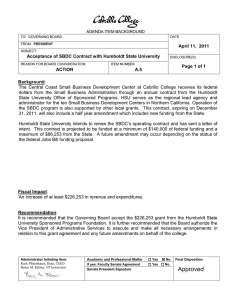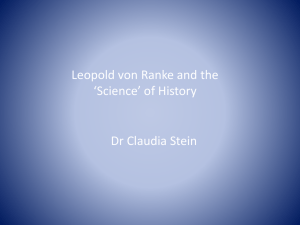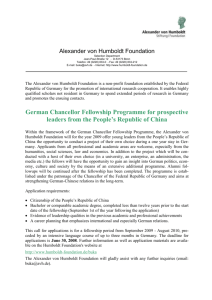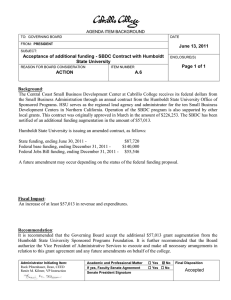WILHELM VON HUMBOLDT
advertisement
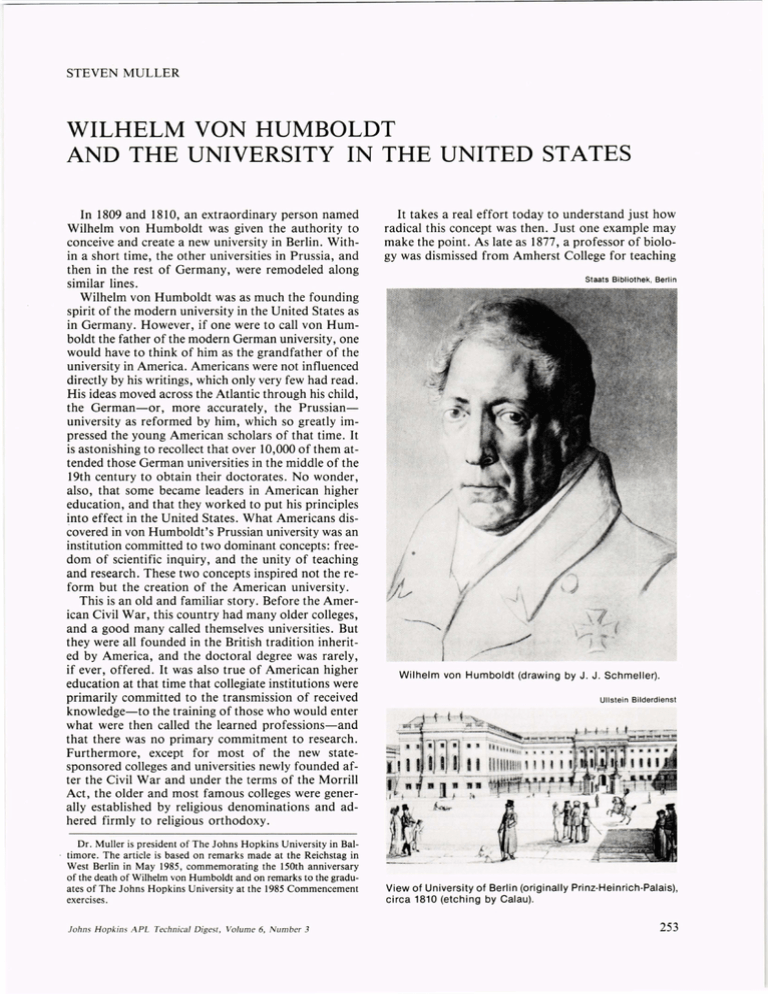
STEVEN MULLER WILHELM VON HUMBOLDT AND THE UNIVERSITY IN THE UNITED STATES In 1809 and 1810, an extraordinary person named Wilhelm von Humboldt was given the authority to conceive and create a new university in Berlin. Within a short time, the other universities in Prussia, and then in the rest of Germany, were remodeled along similar lines. Wilhelm von Humboldt was as much the founding spirit of the modern university in the United States as in Germany. However, if one were to call von Humboldt the father of the modern German university, one would have to think of him as the grandfather of the university in America. Americans were not influenced directly by his writings, which only very few had read. His ideas moved across the Atlantic through his child, the German-or, more accurately, the Prussianuniversity as reformed by him, which so greatly impressed the young American scholars of that time. It is astonishing to recollect that over 10,000 of them attended those German universities in the middle of the 19th century to obtain their doctorates. No wonder, also, that some became leaders in American higher education, and that they worked to put his principles into effect in the United States. What Americans discovered in von Humboldt's Pruss ian university was an institution committed to two dominant concepts: freedom of scientific inquiry, and the unity of teaching and research. These two concepts inspired not the reform but the creation of the American university. This is an old and familiar story. Before the American Civil War, this country had many older colleges, and a good many called themselves universities. But they were all founded in the British tradition inherited by America, and the doctoral degree was rarely, if ever, offered. It was also true of American higher education at that time that collegiate institutions were primarily committed to the transmission of received knowledge-to the training of those who would enter what were then called the learned professions-and that there was no primary commitment to research. Furthermore, except for most of the new statesponsored colleges and universities newly founded after the Civil War and under the terms of the Morrill Act, the older and most famous colleges were generally established by religious denominations and adhered firmly to religious orthodoxy. Dr. Muller is president of The Johns Hopkins University in Bal. timore . The article is based on remarks made at the Reichstag in West Berlin in May 1985 , commemorating the 150th anniversary of the death of Wilhelm von Humboldt and on remarks to the graduates of The Johns Hopkins University at the 1985 Commencement exercises. Johns Hopkins A PL Technical Digest, Volume 6, N umber 3 It takes a real effort today to understand just how radical this concept was then. Just one example may make the point. As late as 1877, a professor of biology was dismissed from Amherst College for teaching Staats Bibliothek, Berlin Wilhelm von Humboldt (drawing by J. J. Schmeller). Ullstein Bilderdienst View of University of Berlin (originally Prinz·Heinrich·Palais), circa 1810 (etching by Cal au). 253 s. Muller - W. von Humboldt and the University in the United States What Americans discovered in von Humboldt's Prussian university was an institution committed to two dominant concepts: freedom of scientific inquiry, and the unity of teaching and research. biology as a science and not "as an absolutely dependent product of an absolutely independent and spiritual creator." In 1876, The Johns Hopkins University opened in Baltimore under the leadership of Daniel Co it Gilman (Berlin, 1854) as a new American university explicitly modeled on Wilhelm von Humboldt's precepts. It was the first true university, in the modern sense, oj the United States and in the United States. The Johns Hopkins faculty consisted mostly of professors who had studied in German universities, and the new university offered the doctorate. Within a few years, Charles William Eliot (Marburg, 1863) reshaped Harvard College into Harvard University, and the university model designed by von Humboldt took root rapidly and firmly throughout the United States. This brief account is not the full nor-in my judgment-even the real story. What was it that made the ideas of freedom of inquiry and the unity of teaching and research so irresistibly attractive to young American scholars? Behind those famous precepts stood a fundamental proposition, not nearly as famous and-at least in the original-almost entirely unknown to Americans! Von Humboldt's fundamental purpose was "das Prinzip zu erhalten, die Wissenschajt als etwas noch nicht ganz Gejundenes und nie ganz Aujzufindendes zu betrachten und unabllissig sie als solche zu such en " [to uphold the principle that views science not as something already found but as knowledge that will never be fully discovered and, yet, needs to be searched for unceasingly]. There, in a few words, is the thought that created the American university as we know it today-the thought that transformed the idea of the university from a training institution primarily devoted to the transmission of established knowledge to the revolutionary concept of an institution primarily committed to the search for, the pursuit of, the discovery of, knowledge. When von Humboldt put forward the idea of freedom of teaching and study, he meant above all, freedom from religious orthodoxy. And the notion that scientific knowledge could be discovered rather than learned as revealed in the past was in fact heretical. Today, when we think of the major American research universities as great centers of scientific inquiry and discovery, we realize all too seldom that the tradition of the university as a research institution and as a center of inquiry is not even two centuries old. We think of centers of discovery, of institutions whose scholars hunt for truth at the frontiers of knowledge. Freedom to search and teaching as part of the quest are not ends in themselves but means to an end. The goal is knowledge, ever new and ever more knowledge; 254 Daniel Coit Gilman (circa 1872), prior to his election as President of The Johns Hopkins University. View of Physics and Astronomy Building , The Johns Hopkins University Downtown Campus (erected in 1886). Johns Hopkin s APL Technical Digest , Volume 6, umber 3 s. Muller - W. von Humboldt and the University in the United States When we think of the major American research universities as great centers of scientific inquiry and discovery, we realize all too seldom that the tradition of the university as a research institution and as a center of inquiry is not even two centuries old. The American research university seen primarily in its graduate phase, closely tied to extensive post-doctoral programs, is ideally suited for intensive research activity-in sharp contrast to the undergraduate colleges, which are not research-intensive. the scientific university searches and searches, and tends to prize the new more than that which is already known . One can easily understand the appeal of the scientific university of discovery to the rapidly industrializing United States of the second half of the 19th century and to the technological superpower of the 20th. But several paradoxes come to mind. One lies in the thought that Wilhelm von Humboldt would surely not wish to claim credit for the contemporary American research university. He would see it as too practical, too vocational, and quite lacking in commitment to the development of the whole human being as well as to the promotion of human civilization in the highest sense. His brother Alexander might perhaps be less critical, but the brothers were not always of one mind. The contemporary German university appears-at least to me-to be somewhat less committed to discovery than is its American counterpart. Certainly it can be observed that although in the United States most of the research not done directly in industrial or government facilities is carried on by the major research universities, the Federal Republic of Germany is rich in national research centers and specialized institutes run by research associations such as Max Planck and Fraunhofer. These facilities are not part of the university system, although, of course, university-based professors are frequently associated with their work. This observation brings me to the most complex paradox of von Humboldt's impact on the American university. Wilhelm von Humboldt reformed not only the Prussian university but also the Prussian school. He is as much the father of the humanistic gymnasium as of the new university, and in fact his model of the university depends entirely on the prior schooling which prepares the student for university work. This is well-known in Germany but almost unknown in the United States, where von Humboldt's thoughts about education prior to the university played no discernible role even though the explicitly named preparatory schools existed in America in von Humboldt's time and still exist. How can it be explained? The fact is that the von Humboldt model of the university did not replace the college system already in place in the United States. Instead, the university was placed on top of the existJohn s Hopkins APL Technical Digest, Volume 6, N umber 3 ing colleges, resulting in the peculiar American pattern of university education consisting of a collegiate, undergraduate base which can then be followed by a later phase of advanced, graduate education. Von Humboldt's reforms inspired in America only this higher stage of advanced graduate development; in effect, the prior collegiate undergraduate stage replaces the preparatory school as the essential education required before entering the graduate stage. When one realizes that von Humboldt's university model applies only to the graduate component of the university in the United States, one can also appreciate that it was, and is, easier in the American university to try to be true to von Humboldt's ideal of individualized instruction and the use of the seminar than is the case in the German universities which d'o not have separate undergraduate and graduate programs. Furthermore, the American research university seen primarily in its graduate phase, closely tied to extensive post-doctoral programs, is ideally suited for intensive research activity-in sharp contrast to the undergraduate colleges, which are not researchintensive. In this respect, von Humboldt's university model may in fact be under less pressure today in the United States than in the Federal Republic of Germany. In the Federal Republic, the effort has had to be made to adapt the model to a much larger number of universities and students than Wilhelm von Humboldt would ever have conceived. Paradoxically, while the American numbers are even larger on both counts, the great mass of American higher education has been, and remains, concentrated at the collegiate, undergraduate level; the relative pressure of numbers at the true university-the advanced graduate level-is actually less in America than in Germany. In one other respect, the university in the United States may actually come closer to Wilhelm von Humboldt than the German university does. This relates to the university's autonomy from the state. Most Americans are not at all familiar with his ideas and writings on the proper limits of government. Even most Germans who know his work are not aware that von Humboldt tried strenuously to anchor the autonomy of the university in a strong degree of financial independence from the state by urging the need for university endowment whose income each year would be available to the university at its own sole discretion. 255 s. Muller - W. von Humboldt and the University in the United States What could be more paradoxical than the fact that a heroic effort to reshape Prussian education along the lines of a classical Greek tradition, which was more imaginary than real, should haye led so directly to the creation in America of precisely the right new uniYersity for the new industrial and technological age? In the United States, the private character of the original colleges and the later growth of private universities achieved precisely this partial financial independence from government which the German university has never had. We represent that vigorous tradition of independence from government on which full academic freedom so profoundly depends. Even the public universities of America are organized in such close imitation of the private institutions that they also share significant sources of income that does not come directly from government. I should now end with apologies for all these paradoxes. I comfort myself with the thought that Wilhelm von Humboldt was so paradoxical in his own life and thought that my remarks might have amused him . And, after all, what could be more paradoxical than the fact that a heroic effort to reshape Prussian education along the lines of a classical Greek tradition, which was more imaginary then real, should have led so directly to the creation in America of precisely the right new university for the new industrial and technological age? The Homewood Campus in Baltimo re of The Johns Hopkins Un iversity, 1985. 256 Johns Hopkin s APL Technical Digest, Volume 6, Number 3

